 Whether you’re looking to improve an existing cart abandonment email or create your first, check these five strategy tips to get the fundamentals right. From cart abandonment subject lines to what you need to do for compliance with GDPR and abandonment emails.
Whether you’re looking to improve an existing cart abandonment email or create your first, check these five strategy tips to get the fundamentals right. From cart abandonment subject lines to what you need to do for compliance with GDPR and abandonment emails.
1. Pep up your cart abandonment email subject lines
The importance of subject lines is no secret. They have the power to nudge people; even people who don’t open your email. Just seeing the right subject line can send someone back to your website or into your shop.
In the consumer email tracking survey by the DMA they asked the question “What is the most important factor in opening an email?”
No big surprise, after the from name the subject line is the key to getting an email read.

What makes a great cart abandon subject line?
Klaviyo looked at abandoned basket subject lines performance across almost 3,000 brands.
In their dataset they found the best performing subject lines are based on the idea of ‘left something behind’. Beating discount based subject lines by 23%.
A lovely example of a left behind subject line with a branding twist is from Jack Erwin
Hey. You left without your shoes…
Rooster Teeth add to the idea with name personalization
Uh oh [NAME], Did you forget something?
In many split test results run across multiple brands, I invariably find adding name personalization increases open rates and at worst is neutral. Try it.
Here’s another 8 ideas for subject line inspiration. I’ve listed these in order of strongest to weakest, as rated by subject line analysis tool Touchstone.
- Your shopping bag is waiting on you!
- We saved your cart for you
- Cart Reserved! [OPEN] to see…
- Missing Something?
- Hi [name], just checking in!
- Your cart MADE us send this reminder
- You left something behind
- Your items are about to disappear
Touchstone analysed up-to 92,251 similar subject lines to rate the above subject lines.
You may be wondering why Klaviyo found left behind subject lines are strong performers but it’s not high in the above list.
It’s likely the mix of brands, verticals and brand size in the Klaviyo data, such as a lot of smaller brands.
The lesson is use other people’s results for ideas and inspiration but never assume it’s the best for your brand and audience. Test whenever you can and make decisions on analysis of your own data, not someone else’s data.
Amazon take personalisation to the next level
This example abandoned email shows how Amazon put the product name in the abandoned cart subject line. Making the subject line highly relevant and standout.
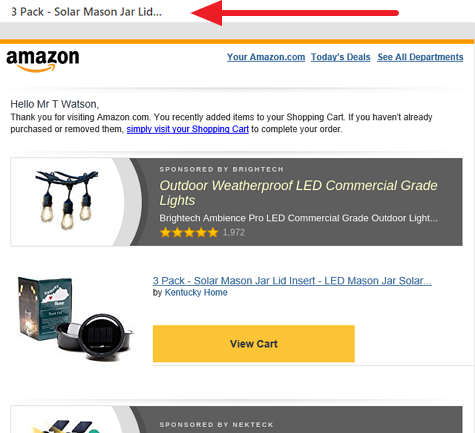
I normally caution against blindly copying marketing tactics from another brand.
Firstly, what works for one brand doesn’t always work for another. Especially in different sectors and with different audience demographics. Amazon have a very diverse range of products and the ultimate in customer diversity. They need something that works at scale and Amazon can’t take advantage of tailoring an emotional subject line to a niche audience.
Secondly, many brands do stuff they have never tested and assume works… never stopping to evaluate results fully.
Amazon put a lot of effort into test and optimization of their marketing. They are unlikely to be including a product name in the subject line because they thought it was a good idea.
I’d put money on Amazon having data that shows the best results for them are when products are included in the subject lines.
2. Make it work for modern consumer cross device habits
Consumers may start their journey on a mobile device and make the final purchase on a desktop or other device.
In the consumer email tracking survey from the DMA they asked the question “if you see something you want to buy in an email on your smartphone, you are most likely to…”
21% wait until returning to their desktop or laptop to make a purchase, but start their journey on mobile.

Whilst many may wait until on a desktop, others will buy straight away or simply add to cart on their mobile.
It’s clear that the consumers switch between devices during the process of online shopping. Criteo report 31% of transactions involve more than one device.
Such as this customer journey example…
Receive a brand email whilst info snacking on mobile, start exploring -> switch to desktop and continue -> add products to cart on desktop -> read browse abandon email on mobile and click -> convert mobile
Because consumers are moving fluidly and continuously between devices just about any combination of activity will happen. Whether that’s starting on mobile and ending on desktop, vice versa or several steps in-between. You need to allow for all possibilities.
The continue shopping link in the cart abandonment email needs to work, even when the cart was created on one device and the email link click is back to the cart on another device.
There are technical reasons why that may not be the case.
Cart abandonment email technologies and eCommerce platforms implement cart creation and tracking in several different ways:
- Keep a cookie on the device with cart contents or to identify the visitor and cart
- Include a person, session or cart id in the continue shopping link
- Include all product sku’s of the cart in the continue shopping link
Only the second two methods give the possibility of reliably showing the abandon cart if the email link is clicked. Regardless of the device on which the cart was created and the device on which the abandon link is clicked.
Check your abandon emails work regardless.
3. Increase your visitor identification rate
You can’t send an abandon email if the site visitor is not identified with email address.
Clients I work with see identification rates between 32% and 61.5%. That’s the percentage of abandoned carts for which the email address is known. Fresh Relevance’s benchmark identification rate for cart abandons is 38.5%.
A big factor is the type of offer and audience. Naturally brands offering products that have higher repeat purchase rates will see higher identification rates. But it’s not the only factor.
Some eCommerce platforms only trigger an abandon if the consumer is logged into their account when they abandon. However, consumers won’t typically log in until the final checkout stage.
A good way to increase identification rates for existing subscribers is through normal broadcast emails. As subscribers click through the email they can be identified and a cookie used.
Using long term cookies for user identification of visitors, either logged in or not logged in helps increase the visitor identification rate for return visitors.
What about new site visitors?
- Getting new visitors to subscribe to your emails is not only good for email marketing list growth, but also means they are identifiable for cart abandonment emails. Using popups and multiple ways to subscribe is a win-win.
- Ask for their email address early in the checkout process, before the abandon might happen.
Clarks Shoes start the checkout process with only one text field to be completed, the email address.
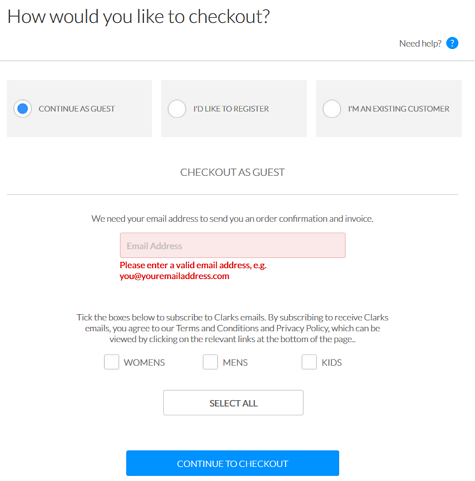
By making this a simple initial step they collect an email address that might never have been provided had a more complicated checkout page be the first step.
Contrast this with the Crocs (coming later in this article). Crocs don’t collect the email address until much later, the shipping information stage. The abandon event might happen before the customer ever gets to provide an email address.
4. Avoid the abandon
An abandonment email is glue to fix a problem that happened earlier.
Better than sending the email is not having an abandon in the first place. This survey from Baymard Institute gives clues as to the common causes of abandon.
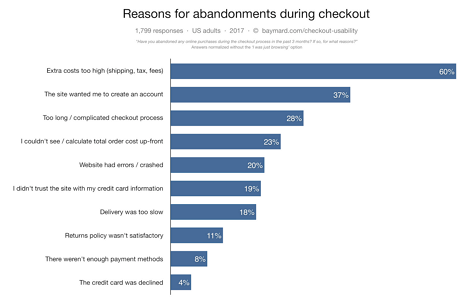
Brands typically feel compelled to only show shipping and extra costs until later in the process because if shown earlier it makes prices look less favourable than other brands, that also show the extra costs later.
Thankfully some of the other causes are clearer cut and fixable
- The site wanted me to create an account –> use a guest buyer process.
- Too long / complicated checkout –> de-clutter the page, use auto-fill such address suggestions from zip codes. Even changing the visual look of a checkout can make it feel shorter.
- Website had errors –> Ok… that shouldn’t happen. Make sure you are monitoring your website for failures so you know if you’ve a reliability issue.
5. Abandoned basket GDPR compliance
Storing data and sending marketing to EU citizens requires GDPR (data storage/processing) and PECR (marketing permission) compliance.
That’s easy in the case you already have marketing consent for the site visitor, such as when they are known and already a subscriber to your newsletter. Or they have purchased from you before, aka ‘existing customer relationship’, and you’ve shown a legitimate interest for GDPR compliance.
But what about new site visitors who through the checkout process share their email address with you for the first time?
GDPR compliance leaves two options for emails:
- Soft opt-in (PECR) and legitimate interest (GDPR)
- Consent, covering both PECR and GDPR
With option 1, you must provide the opportunity for people to opt-out at time of data capture, as well as demonstrating your legitimate interest.
And for option 2, you must collect affirmative and consent that is not bundled with the rest of the transaction. Rather than defaulting to opt-out use a no default method. The evidence shows it to be the most successful method for getting consent.
Let’s look at brand examples of both methods.
Carphone Warehouse are using a soft opt-in during the checkout. That means they offer the possibility to opt-out, but if no action is taken, then they have permission (PECR) to send cart abandon emails.
Their GDPR compliance is via legitimate interest and under legitimate interest in their privacy policy they include this:
“For marketing activities (other than where we rely on your consent) e.g. marketing permissions captured during the course of a sale”
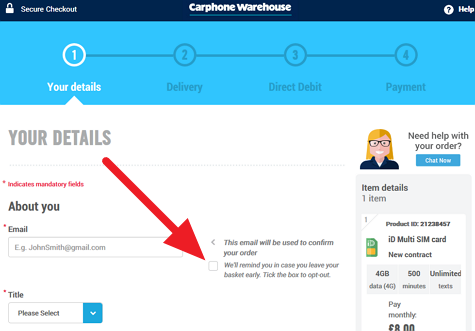
Crocs checkout is an example of consent with an affirmative action, visitors must tick the box. Only for contacts that tick the box can a cart abandonment email be sent.
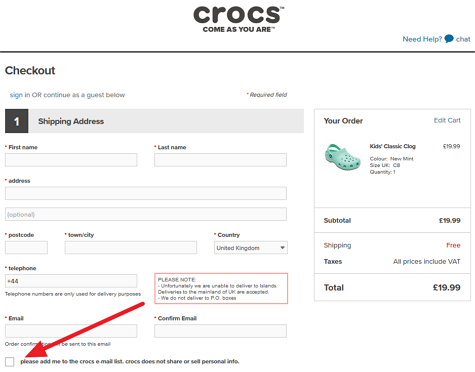
Summary
- Personalise abandoned cart subject lines with name or product name and test them too.
- Ensure a great user experience, even when consumers switch between devices.
- Pay attention to your identification rate and take measures to increase it.
- Fix problems that cause abandons
- Make sure your cart abandonment process is GDPR compliant – if you market to the EU.
Wondering why I haven’t included adding discounts to abandon cart emails? It may not be a good idea, take a look at point 2, discount strategy for the pros and cons.
